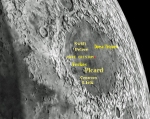Green Cheese? Anyone!
Focus your time machine to the stars on the features along the Moon's limb during the month of September. This is a rare chance to view a few limb sections of the Moon that star gazers have dreamed of taking a closer look at for generations, during a single month of the year. Astronauts didn't report any green cheese, so our ancestors can rest safely, as we have ruled out green cheese as the main ingredient in the physical composition of the Moon.
Watch as the crescent Moon waxes, between September 11 to 13, and take a close look at Mare Crisium, and how far this feature is from the eastern edge. The features on the limb that you'll notice will be the elongated dark patches of Mare Smythii and Mare Marginis. The regions near the south-eastern limb will feature primarily bright highlands that will slowly change as the 18 of September approaches and the mottled Mare Australe rotates into view.
Focus your time machine to the stars on the hilly south polar region a few nights later and you'll see nice 3D effects that catch-the-eye of the viewer and Mare Smythii and Mare Marginis will have disappeared from view.
A Full Moon will greet star gazers on September 23 and this is the perfect time to take a look at some of the best features on the Moon's surface. Mare Orientale will appear along the Moon's western limb on September 23. A magnificent impact basin, with multiple visible rings and lava lakes, get your timing right over the next few nights, and you'll witness a scene few humans have experienced. Watch patiently and you'll see the rings appear in profile first. This scene will slowly change as the Moon's libration and the rotation of the Earth bring the lava pools of Lacus Veris and Lacus Autumni into view.
In : the Moon
